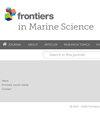深海Vema断裂带硬基质预测的确认
IF 3
2区 生物学
Q1 MARINE & FRESHWATER BIOLOGY
引用次数: 0
摘要
水声测绘最近通过预测这种环境中大量栖息地的异质性,挑战了长期以来关于均匀深海海底的观点。碎石队M205在Vema断裂带(VFZ)的六个地点使用拖曳式深海相机系统进行视觉调查,验证了这些预测。在硬岩暴露程度高的地区,暴露的岩石露头和各种硬基质得到了一致的证实,而适度预测的地区包含沉积物、鹅卵石和鹅卵石的混合物;低潜力地点几乎完全被沉积物覆盖。虽然详细的量化超出了本报告的范围,但视觉对应支持深海栖息地水声预测的可靠性。值得注意的是,这项研究率先将基于水声的海底表征应用于深海深度——将以前专注于深海区的方法扩展到地球上最大的底栖生物环境,并使5000米以下栖息地模型的直接地面真实化成为可能。这些发现突出了深海生境的异质性,证实了水声工具在大尺度底栖生物测绘中的应用,并为未来深海生物多样性和生态动力学研究奠定了基础。本文章由计算机程序翻译,如有差异,请以英文原文为准。
Confirmation of hard-substrate predictions in the abyssal Vema Fracture Zone
Hydroacoustic mapping has recently challenged the long-held view of a uniform abyssal seafloor by predicting substantial habitat heterogeneity in this environment. The RUBBLE expedition M205 validated these predictions in the Vema Fracture Zone (VFZ) with visual surveys at six locations using a towed deep-sea camera system. Exposed rock outcrops and varied hard substrates were consistently confirmed in areas of high hard-rock exposure, while moderately predicted areas contained a mix of sediments, cobbles, and pebbles; low-potential sites were almost entirely covered in sediment. Although a detailed quantification is beyond the scope of this report, visual correspondence supports the reliability of hydroacoustic predictions for abyssal habitats. Notably, this study pioneers the application of hydroacoustic-based seafloor characterization at abyssal depths—extending methods formerly focused on bathyal zones to the planet’s largest benthic environment and enabling direct ground-truthing of habitat models below 5,000 m. These findings highlight abyssal habitat heterogeneity, confirm the utility of hydroacoustic tools for broad-scale benthic mapping, and establish a baseline for future research on deep-sea biodiversity and ecological dynamics.
求助全文
通过发布文献求助,成功后即可免费获取论文全文。
去求助
来源期刊

Frontiers in Marine Science
Agricultural and Biological Sciences-Aquatic Science
CiteScore
5.10
自引率
16.20%
发文量
2443
审稿时长
14 weeks
期刊介绍:
Frontiers in Marine Science publishes rigorously peer-reviewed research that advances our understanding of all aspects of the environment, biology, ecosystem functioning and human interactions with the oceans. Field Chief Editor Carlos M. Duarte at King Abdullah University of Science and Technology Thuwal is supported by an outstanding Editorial Board of international researchers. This multidisciplinary open-access journal is at the forefront of disseminating and communicating scientific knowledge and impactful discoveries to researchers, academics, policy makers and the public worldwide.
With the human population predicted to reach 9 billion people by 2050, it is clear that traditional land resources will not suffice to meet the demand for food or energy, required to support high-quality livelihoods. As a result, the oceans are emerging as a source of untapped assets, with new innovative industries, such as aquaculture, marine biotechnology, marine energy and deep-sea mining growing rapidly under a new era characterized by rapid growth of a blue, ocean-based economy. The sustainability of the blue economy is closely dependent on our knowledge about how to mitigate the impacts of the multiple pressures on the ocean ecosystem associated with the increased scale and diversification of industry operations in the ocean and global human pressures on the environment. Therefore, Frontiers in Marine Science particularly welcomes the communication of research outcomes addressing ocean-based solutions for the emerging challenges, including improved forecasting and observational capacities, understanding biodiversity and ecosystem problems, locally and globally, effective management strategies to maintain ocean health, and an improved capacity to sustainably derive resources from the oceans.
 求助内容:
求助内容: 应助结果提醒方式:
应助结果提醒方式:


